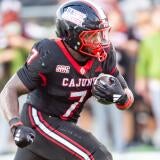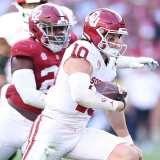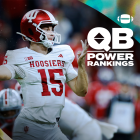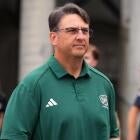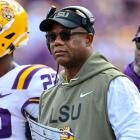Biggest challenge facing each new coach in their first season at a Power Five school in 2023
Roster competition and culture battles will take center stage for 11 new Power Five coaches

The 2022 offseason didn't quite match the fireworks of the prior year. However, when the dust settled on the coaching carousel, 11 FBS programs emerged with new coaches, with three moving from one Power Five institution to another.
While the names aren't earth shattering, the challenges could be. Zach Arnett has to replace the legendary Mike Leach at Mississippi State. Deion Sanders is tasked with completely revamping a moribund Colorado program. Matt Rhule faces expectations of getting Nebraska back to national contention. New eras at Stanford and Wisconsin are on the horizon.
Here is the biggest challenge that each Power Five coach will face at their new job.
Zach Arnett, Mississippi State
Flipping out the offense: After Arnett was named the coach of the Bulldogs, he quickly decided to move away from the Air Raid system that defined Mississippi State under the late Mike Leach. In addition to hiring a young coordinator with deep ties in the Jim McElwain system, three Air Raid quarterbacks, seven receivers and four offensive linemen ultimately left the program. The Bulldogs did prioritize tight end transfers and retained top quarterback Will Rogers, but turning an Air Raid offense into a pro spread scheme could take time. Arnett is one of the nation's rising defensive minds, but patience will be short in Starkville.
Jeff Brohm, Louisville
Handling the hype: Louisville publicly clamored for Brohm for years and finally landed the hometown kid after he led Purdue to a Big Ten West title. While Brohm has deep familiarity with the Cardinals after playing and coaching there, Louisville is a different program – for better and worse – than when Brohm was on staff. Brohm now has to deal with expectations of bringing the Cardinals to ACC and national prominence despite the program not posting a nine-win season since Heisman winner Lamar Jackson graduated.
Kenny Dillingham, Arizona State
Integrating transfers: Dillingham is the youngest coach in the Power Five at just 33 years old, but already has an aggressive plan to revamp his alma mater. The new staff got to work quickly adding new talent and the Sun Devils trail only Colorado in transfers added with 28. Integrating transfers can be a tricky game, especially as a first-time head coach tries to discover his voice. Dillingham is battle-tested at some of the top programs in the nation, but winning in Tempe will be a difficult challenge.
Luke Fickell, Wisconsin
Breaking tradition: When Fickell took this job, he opted to aggressively transform one of the most recognizable power offenses in college football into an up-tempo spread scheme. Offensive coordinator Phil Longo has a lengthy track record developing quarterbacks and passing offenses. He most recently helped turn UNC quarterback Drake Maye into a Heisman contender. Early reviews of the Longo offense have been good, but dealing with the fanbase when the Badgers fail to convert their first third-and-2 could come with some headaches.
Hugh Freeze, Auburn
Rebuilding the offensive line: Needless to say, Freeze was one of the more surprising hires of the offseason after his previous unceremonious exit from the SEC. However, Freeze has managed to hit the ground running after landing the No. 2 transfer class in the nation and pushing the high school class into the top 20 nationally despite a short turnaround. The biggest question is on the offensive line, where the Tigers ranked bottom 40 nationally in sack rate allowed and standard downs line yards, per Football Outsiders. Freeze was aggressive at the position, landing five transfers and four high school recruits to try and quickly patch holes. Will it be enough?
Brent Key, Georgia Tech
Bring some Tide to Atlanta: From 2016-18, Key served as offensive line coach at Alabama. Georgia Tech's new athletic director J Batt spent six years with the Crimson Tide, eventually topping out as chief revenue officer, and saw potential in Key. Few programs need an infusion of Alabama swagger quite like Georgia Tech, a gem right in the heart of Atlanta that's essentially punted on contention for decades. Fired coach Geoff Collins tried to play to the local clientele but ultimately proved unable to build bridges between recruiting, branding and on-field success. Unlike Collins, Key has been around nationally competitive programs and can follow the same roadmap to success.
Matt Rhule, Nebraska
Building a culture: After hometown favorite Scott Frost failed, the Cornhuskers opted to go a completely different direction and hire a Northeasterner via Texas and the NFL. However, Rhule has fashioned himself a chameleon of sorts, finding inroads and building relationships at every stop. Nebraska has been no different, as Rhule helped bring former Nebraska coach Frank Solich back to campus during the spring game. Nebraska has lacked the vaunted Blackshirt swagger since Bo Pelini left the program almost a decade ago. Rhule's first year may not come with many wins, but few coaches in the sport bring a more physical culture than him.
Deion Sanders, Colorado
Revamping the roster: In one offseason, Sanders has taken perhaps the most aggressive roster-building approach we've ever seen. Nearly 70 scholarship players have joined the team since "Coach Prime" took over in December, with another wave leaving the program after spring camp. Essentially, the Buffaloes will discover exactly how much established chemistry means, as the vast majority of players have never played a game next to each other. If Sanders manages to land this plane, it will be the story of the year in college football. If he doesn't, it still might!
Scott Satterfield, Cincinnati
Finding an identity: Satterfield was a highly successful coach at Appalachian State and helped the program transition seamlessly to the FBS. At Louisville, things never quite went according to plan. Now, Satterfield has turned over a new leaf at a transitioning Power Five program where he hopes to find a balance between his previous two stops. Satterfield turned to former App State assistant Brad Glenn to run the offense and brought star Louisville defensive coordinator Bryan Brown to Cincinnati with him. The Bearcats are a far different kind of program than Appalachian State, but Satterfield would do well to find pieces -- schematically, developmentally and beyond -- that can connect him to his past success.
Troy Taylor, Stanford
Build a new model: For the last 15 years, Stanford has lived and died by Intellectual Brutality, the physical approach that spanned the Jim Harbaugh and David Shaw eras. In Taylor, the Cardinal are heading in a new direction. The former Cal quarterback led an offensive renaissance at Utah and experimented heavily at Sacramento State before earning the promotion. Identifying and recruiting talent is difficult at Stanford because of academic requirements and Taylor will have to find his unique path to success, especially with a roster decimated by transfers.
Ryan Walters, Purdue
Preparing the QB: The Boilermakers turned heads when they beat many top programs to land Texas transfer quarterback Hudson Card. Card was the No. 3 transfer in the 247Sports Transfer Rankings -- trailing only future NFL Draft picks Devin Leary and Sam Hartman -- and has a strong chance to turn heads in Graham Harrell's Air Raid offense. Walters has a strong defensive track record across his stints at Missouri and Illinois. If Card can be ready for the grind of a Big Ten schedule, it will give Walters a chance to let the defense grow up and, like Brohm before him, to make Purdue competive in the Big Ten West.





